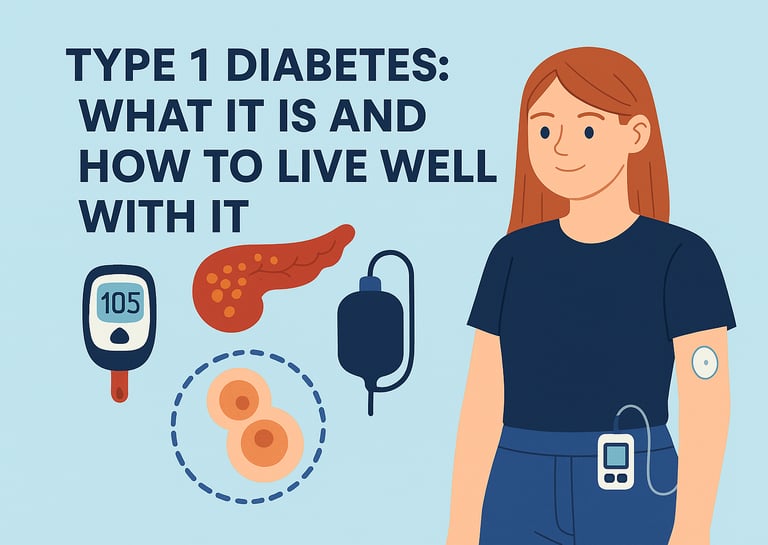Stay updated on what is trending in health. Discover tips and resources for a healthier, balanced life.
Type 1 Diabetes: What It Is and Why Representation Matters
Type 1 diabetes is an autoimmune condition where the body stops making insulin. Learn the symptoms, causes, treatment options, and how to thrive while managing this lifelong condition.
DISEASES AND CONDITIONS
Dr. S. Ali
7/10/20255 min read


What Is Type 1 Diabetes?
Imagine your pancreas is like a little factory that makes insulin — the hormone that helps your body turn sugar (glucose) into energy. In Type 1 diabetes, your immune system mistakenly attacks and destroys those insulin-making cells. As a result, your body can’t regulate blood sugar levels on its own.
Unlike Type 2 diabetes, which can develop over time and is often linked to lifestyle, Type 1 is usually diagnosed in children, teens, or young adults, although it can occur at any age.
What Causes It?
We don’t know the exact cause yet, but it’s believed to be a mix of genetics and environmental triggers. You might inherit a higher risk from your family, and something — maybe a virus — flips the switch.
Here’s the key point: You don’t get Type 1 diabetes from eating too much sugar. That’s a common myth.
Symptoms to Watch Out For
The symptoms often come on quickly — sometimes over just a few weeks. Be on the lookout for signs like:
Constant thirst – You might feel like no matter how much water you drink, you’re still parched. This happens because high blood sugar pulls fluid from your tissues, making you feel dehydrated.
Frequent urination – Since your body is trying to flush out excess glucose, you may find yourself running to the bathroom more often than usual, even waking up several times at night.
Sudden weight loss – Even if you’re eating normally or even more than usual, your body can’t use glucose properly for energy, so it starts breaking down fat and muscle instead.
Fatigue – Without insulin, glucose can’t enter your cells, so you’re left feeling tired and sluggish, even after rest or sleep.
Blurry vision – High blood sugar can pull fluid from the lenses of your eyes, affecting your ability to focus and making your vision seem cloudy.
Increased hunger – Since your cells are starved of energy, your brain gets the message that you need more food — leading to intense and persistent hunger.
Mood changes or irritability – Low energy, blood sugar swings, and the stress on your body can all contribute to feeling more emotional, moody, or easily frustrated.
In children, these signs may be mistaken for the flu or a growth spurt, so if anything feels off, it’s worth getting checked.
How Is It Diagnosed?
If you or your child starts showing symptoms of Type 1 diabetes — like extreme thirst, frequent urination, or unexplained weight loss — it’s important to see a doctor right away. The sooner you get a diagnosis, the better the chances of avoiding serious complications like diabetic keto-acidosis (DKA).
Your doctor will usually begin with a few key tests:
Blood glucose test – This checks the amount of sugar in your blood at a specific moment. If the levels are higher than normal, it could point to diabetes.
A1C test – Also known as the hemoglobin A1C test, this gives a snapshot of your average blood sugar levels over the past 2 to 3 months. A high A1C means your blood sugar has been elevated for a while, which helps confirm the diagnosis.
Autoantibody tests – These tests look for specific antibodies in your blood that are commonly present in Type 1 diabetes. Since Type 1 is an autoimmune disease, the presence of these antibodies helps distinguish it from Type 2 diabetes or other conditions.
Sometimes, doctors may also check ketone levels in the urine or blood — especially if the patient is very sick, tired, or vomiting. High ketones can signal DKA (diabetic keto- acidosis), a potentially life-threatening emergency that occurs when the body starts breaking down fat too fast due to a lack of insulin.
Professional tip: If you suspect diabetes, don’t delay testing. Even a simple finger-prick glucose check at a clinic or pharmacy can be a life-saving first step.
Treatment: It's All About Insulin
Since your body no longer makes insulin, you’ll need to take it daily — either through injections or an insulin pump. There’s no cure yet, but treatment has come a long way.
Many people use continuous glucose monitors (CGMs) to track blood sugar in real time, making daily management easier.
Can You Live a Normal Life with Type 1 Diabetes?
Absolutely — with the right care. Many athletes, celebrities, and professionals thrive with Type 1 diabetes. While it requires daily effort, modern tools and strategies make it manageable.
Here’s what helps:
Monitoring blood sugar regularly – Frequent checks or continuous glucose monitors (CGMs) help you stay in range and adjust insulin quickly.
Taking insulin as prescribed – Whether via injections or a pump, consistent insulin delivery is vital for balancing blood sugar.
Eating a balanced diet (carb-counting is key!) – Understanding how foods affect glucose levels lets you enjoy meals while maintaining control.
Staying active – Exercise improves insulin sensitivity, but requires planning to avoid lows (always carry fast-acting carbs!).
Having a support system – Friends, family, or a diabetes care team provide encouragement and help during challenges.
Long-Term Health: What to Watch For
Prevention is possible! With consistent management, risks drop significantly. Key areas to monitor:
Eyes (diabetic retinopathy) – High blood sugar can damage retinal blood vessels; annual eye exams catch early signs.
Kidneys (nephropathy) – Regular urine tests check for protein leaks, a marker of kidney stress.
Nerves (neuropathy) – Tingling or numbness in hands/feet signals nerve damage; tight glucose control slows progression.
Heart and blood vessels – Diabetes raises cardiovascular risks, so manage blood pressure and cholesterol proactively.
The good news: Advances in insulin pumps, CGMs, and research (like artificial pancreas systems) are making long-term health easier to achieve than ever.
The Emotional Side Matters Too
Living with a lifelong condition can take a toll mentally. It’s okay to feel overwhelmed sometimes. Don’t hesitate to seek out a therapist or support group — managing your mental health is just as important as managing your blood sugar.
Representation Matters: Barbie with Type 1 Diabetes
Living with diabetes, especially as a child, can feel isolating. That’s why it’s so powerful when toys and media reflect real health conditions. Mattel recently introduced a Barbie doll with Type 1 diabetes, complete with a glucose monitor and insulin pump — making it one of the first mainstream dolls to showcase this condition.
This Barbie helps normalize diabetes management and sparks conversations about chronic illness. More importantly, it reminds children with diabetes: You’re strong, capable, and just as adventurous as anyone else.
Final Thoughts
Type 1 diabetes may be a lifelong condition, but with modern tools, knowledge, and support, it doesn’t have to hold you back. The key is learning how your body works — and giving it what it needs.
If you or a loved one has Type 1, know this: you are not alone, and you can live a strong, healthy life.
Sources:
American Diabetes Association (ADA)
https://www.diabetes.org/diabetes/type-1Juvenile Diabetes Research Foundation (JDRF)
https://www.jdrf.org/Mayo Clinic – Type 1 Diabetes
https://www.mayoclinic.org/diseases-conditions/type-1-diabetesNational Institute of Diabetes and Digestive and Kidney Diseases (NIDDK)
https://www.niddk.nih.gov/health-information/diabetes/overview/what-is-diabetes/type-1-diabetesCenters for Disease Control and Prevention (CDC)
https://www.cdc.gov/diabetes/basics/type1.html
NHS UK – Type 1 Diabetes
https://www.nhs.uk/conditions/type-1-diabetes/Diabetes Canada – Type 1 Diabetes
https://www.diabetes.ca/about-diabetes/type-1-diabetesPubMed Central (PMC)
https://www.ncbi.nlm.nih.gov/pmc/?term=type+1+diabetes
Pulse Your Health
Empowering you to achieve your health goals.
Contact
© 2025. All rights reserved.
Disclaimer: The content on this website is for informational purposes only and is not medical advice. Always seek the advice of your physician or other suitably qualified healthcare professional for diagnosis, treatment and your health related needs.
